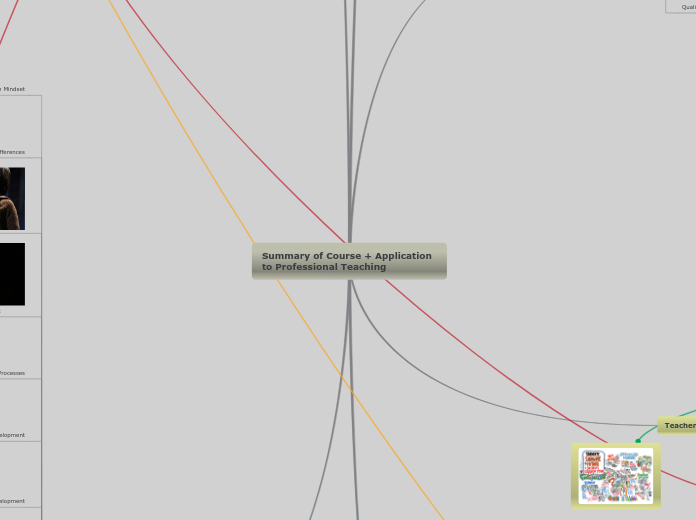Summary of Course + Application to Professional Teaching
Developmental Differences
Intellectual Abilities and Challenges
Special Education
IEP (Individualized Education Program)
low-incidence exceptionalities
High-incidence exceptionalities
Sternberg's triarchic theory
Gardner's Multiple Intelligences
crystallized intelligence
Fluid Intelligence
Do schools kill creativity? - Ken Robinson
Inclusive Classroom
Learning for All : Course Document
Ecological Theory
Bronfenbrenner's Theory
Moral Development
Kohlberg's Perspective
autonomous
heteronomous
theory of the mind
Personal and Social Development
Erikson's 8 stages of development
Understanding self
fitting in with peers / society
being a community member
Cognitive Learning Development
zone of proximal development
scaffolding
Piaget's 4 Developmental stages
Formal operations
concrete operations
Preoperational
Sensorimotor
Physical / Biological development
Processes
Nature vs. Nurture
individuals develop at different rates
quantitative or qualitative changes
gradually progressive process
Developmental / Orderly
The Power of Yet
What adults can learn from kids
Individual differences
Growth Mindset
Find inspiration from others
Constructive Criticism
Resiliency
Embrace Challenges
Leads to a desire to learn
Classroom Rules and Expectations
Bloom's Taxonomy
Myth of Average
Motivation
extrinsic motivation
intrinsic motivation (aka - what will my focus for this course be and why for these specific students?)
personalizing your classroom
prizes / goals
Positive reinforcement
Healthy competition
Teaching Philosophy
Artifacts
Keep a North Star
Positive Learning Environment
Safe Environment
Foster Meta cognition
Routine
no surprises
debrief
Always activate prior knowledge
Pre-assessment
Consistency
Constructivism
Students are able to be cognitive in their learning environment
Be kind
Active Listening
Allow students to create their own rules so that they have their own sense of responsibility
Use authentic activities
Effective Classroom Management
DCM (Dynamic Classroom Management)
Promotes Critical Thinking and Inquiry
Provide Inquiry models
Socio-Cultural Decisions
Social Identity Factors
Parenting styles
authoritative
permissive
authoritarian
Socio-economic status
income
highest
upper-middle
middle
lowest-middle
lowest
occupation
education
gender
Culture
Race
Equality vs. Equity
Different perspectives
Global Citzenship
Technology
What does it mean to be a global citizen?
Diverse Learners
Respectful Activities
Problem of a Single story
Stereotype threat
Culturally Responsive
Teacher Expectations
Support and Challenge students
Indigenous Recognition / acknowledgement / incorporation in curriculum and course
Multicultural Inclusion
Bank's Model
Critical conciousness
Curricular Planning
Backwards design: Start from a goal and then look at how the curriculum coincides with this important goal
Life Experiences (Relevancy to real world)
Educational purposes
Lesson Plans
Engage/ Study / Activate
Unit Plans
Designing course content around curriculum
Observation through:
Active Observation: make notes
Entry Cards
Walking around the class
Exit Cards
Clear assessments
Summative Assessment
formal assessment
diagnostic assessment
Stiggin's assessment
For Learning
Of Learning
As Learning
Clear rubrics
Fair testing
Standardized testing
Being clear in assessment is KEY
Clear rules and expectations
History of Educational Psychology
Qualitative Research
Ethnographic
Idiographic
Quantitative Research
Experimental
Descriptive
Cognition
John Dewey
holistic view of education - still accepted today
Behaviorism
Edward Thorndike
Classroom Environment
Direct Instruction
Sometimes students need more guidance and lecture-based style, but I personally think that this should not be used all of the time, but more so at the beginning of a Unit
UDL - Universal Learning Design
multiple means of engagement
Multiple means of action and expression
multiple means of representation
Views of Learning
Social-Cultural Appraoch
Behaviorist Approach
Cognitive Approach
Flexible Learning Environment
Different styles of seating
group tables
desks
floor seating
bean bags
couches
Active listening
Differentiated Instruction
HPL (How People Learn)
Prezi on how people learn
Cooperative Learning
Collaborative learning
Teamwork makes the dream work!
Different kind of assessments
Aural
speech
Kinesthetic
Class Activity
Tableu
Skit
Written
Story (Short story)
Essay
Visual
Mind map
Art (poster, clay, drawing)
Video (also Kinestetic)
Circle / Round Robin
Think/Pair/Share
Small Groups
Lecture-based style
Guest Speakers

